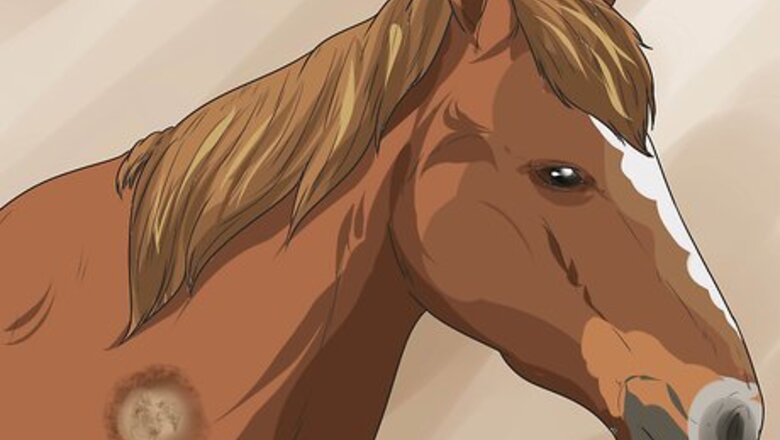
views
Identifying Ringworm

Look for signs of a ringworm infection. A horse may be infected for up to three weeks before signs develop and therefore look entirely normal. Typically, the first hint of infection is patches or tufts of hair that don't lie flat and stand a little proud of the coat. This is because the ringworm fungus invades the hair shaft and weakens the hairs which makes them stand at a strange angle. These hairs are easy to pluck out because of the damage to the hair shaft. Areas where the skin is rubbed regularly, such as on the neck along the line of the reins, or behind the thighs where the rug string rubs, are more vulnerable to infection. The skin in these areas is slightly worn away and weakened by the friction. Also areas such as the nose and muzzle are at increased risk, as the horse explores water and feed bowls used by other (possibly infected) horses. Ringworm lives off superficial, dead skin cells and hair, so lesions appear on the skin's surface. As the infection progresses the damaged hairs are shed, leading to small bald patches. Often there are multiple patches that have the appearance of round, bald, scaly areas. These are often grouped together on the neck, withers, or behind the thighs, although any area can be affected. As the infection becomes mature, the bald areas may coalesce together to form larger bald areas. These patches are often scaly and may have a grey, 'cigarette ash" tinge to them. Crusts may form over the bald area, but these are not a sign of healing, indeed the crusts can protect the fungi and make it more difficult to treat.

Keep a close eye on horses at high risk of infection. Young horses and horses who have come into contact with an infected horse are at high risk of infection. Young horses are at great risk because their immune systems have not met the fungus before and so don't know how to fight it off. Older horses, especially those who have had infection in the past, may develop a degree of immunity that lessens the effects of ringworm in the future. Unfortunately, a common way to catch ringworm is from other infected horses. This can happen simply by rubbing against a fence or stable touched by another infected horse. Indeed, tack such as reins, girths, or saddles, or equipment such as riding boots can become infected and act as a source of transmission from one animal to another. Another problem is that it can take up to three weeks before an infected horse shows signs of the infection. During this time the horse may be in contact with other horses or be transported in a trailer and rub against the walls, which acts as a source of infection for others. However, remember that the fungus that causes ringworm occurs naturally in the environment and in the soil. Contact of the skin with the fungus can lead to colonization of the skin and an infection developing.
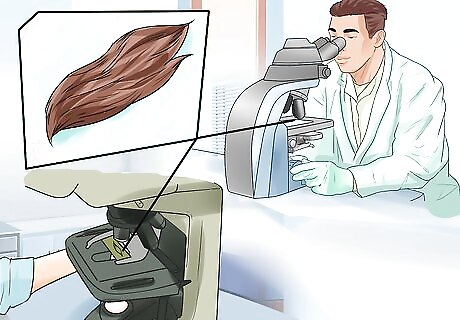
Get the ringworm diagnosed by a veterinarian. You want to get a professional diagnosis in order to verify that your horse is indeed infected. Your vet will diagnose ringworm either by examining samples of plucked hairs under the microscope to look for the fungus or fungal spores, or by placing pieces of hair onto a special nutrient plate that changes color in the presence of ringworm.
Treating Ringworm

Isolate the infected horse. You need to limit the spread of the infection, which is done by keeping the infected horse away from uninfected horses. Where possible, it is best to isolate the horse for 2-3 weeks during and after treatment to reduce the risk of spreading the infection.
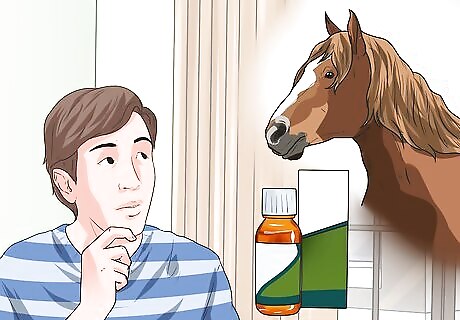
Assess whether treatment is necessary. In some cases, the horse's immune system will fight off the infection. In these cases the infection is considered 'self-limiting,' meaning that no treatment is necessary to cure that horse. However, because of the risk of infection and widespread shedding of fungus into the environment, it is advisable to treat ringworm before it has run its course. It can take around 6 - 15 weeks for self-cure to take place. During this time the horse is a source of infection to other horses. If the lesions are itchy and the horse rubs a lot, the ringworm patches may get infected are require further veterinary attention. Signs of infection include reddening of the area, inflammation, scabs formation, or weeping or discharge from the area.
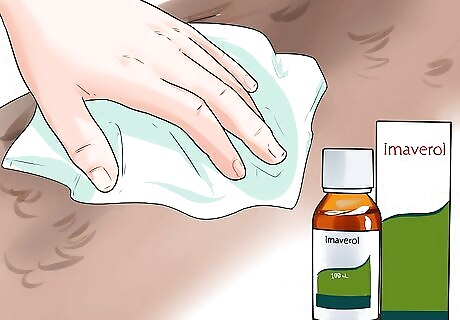
Apply a topical treatment for ringworm. The first line of treatment is to use a topical treatment that is wiped over the affected areas to damage and kill the fungus. The product licensed for use in horses contains a drug called enilconazole (Imaverol). This is a liquid which damages the structure of the fungus and kills spores. It should be applied to the skin and hairs every three days for at least four treatments. Imaverol is concentrated and needs dilution prior to use. 1 ml of Imaverol is added to 50ml of water to make a 0.2% solution. It is best to spray the whole horse for the first treatment, in order to contact any fungus which is present but not yet showing signs of infection. After than it is acceptable to treat the infected areas only with a margin of skin around them to catch any sideways spread. The diluted Imaverol needs to contact the fungus, therefore scabs need to be removed first. This can be done by soaking them in a shampoo Malaseb (containing an antifungal agent, miconazole) and then picking them off or brushing gently with a toothbrush. Take care to wear gloves so that your skin doesn't become affected. After removing the scabs, thoroughly dry the skin so that water doesn't further dilute the Imaverol and weaken its action.
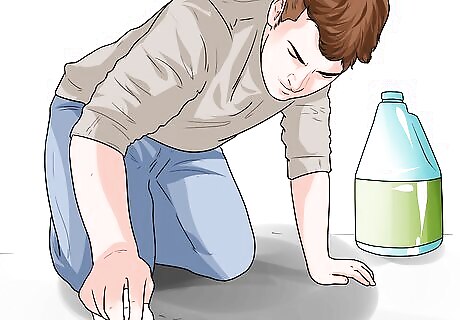
Clean all equipment and areas that the infected horse has been in contact with. Use any leftover Imaverol solution to wipe down reins and tack to decrease the risk of spread via equipment. It is also advisable to scrub down woodwork and surfaces with a 10% solution of bleach to kill the ringworm spores, which could pose a source of future infection.

Give your horse oral medication for ringworm if topical treatment is not effective. Oral medication, such as antifungal Griseofulvin, can be is added to the horse's feed. This treatment is usually reserved for hard-to-treat cases that are resistant to topical therapy. The horse receives treatment daily for 7 days. However, this treatment works from the inside out, and takes longer to be effective as the fungus need to contact the chemical in the blood. Also, some of the shed fungus could potentially still be infective.

















Comments
0 comment